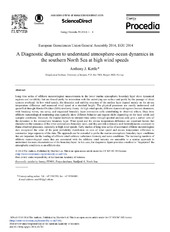| dc.description.abstract | Long time series of offshore meteorological measurements in the lower marine atmospheric boundary layer show dynamical regimes and variability that are forced partly by interaction with the underlying sea surface and partly by the passage of cloud systems overhead. At low wind speeds, the dynamics and stability structure of the surface layer depend mainly on the air-sea temperature difference and measured wind speed at a standard height. The physical processes are mostly understood and quantified through Monin-Obukhov (MO) similarity theory. At high wind speeds, different dynamical regimes become dominant, with breaking waves, sea spray, and organized boundary layer convection cells contributing to observed effects. Data from offshore meteorological monitoring sites typically show different behavior and regime shifts depending on the local winds and synoptic conditions. However, the regular methods to interpret time series through spectral analysis only give a partial view of the dynamics in the atmospheric boundary layer. Wind speed and the air-sea temperature difference are important factors that characterize the dynamics of the lower atmospheric boundary layer, and they provide a dynamic and thermodynamic constraint to frame observed processes, especially at high wind speeds. Early studies of long time series of automated offshore meteorological data recognized the value of the joint probability distribution on axes of wind speed and air-sea temperature difference to summarize large segments of the data. The approach can be extended to probe the marine atmospheric boundary layer conditions that are important for the loading of offshore wind turbines: turbulence intensity and wave conditions. The increasing numbers of offshore meteorological masts that are associated with the offshore wind industry are amenable to a similar approach to understand the main characteristics of the boundary layer. In this case, the diagnostic figure provides a method to ‘fingerprint’ the atmospheric conditions at an offshore site. | en_US |

